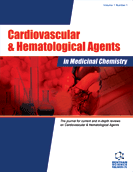Abstract
Background: There are data indicating that several azonine-derivatives may exert effects on some biological systems; however, there is very low information on the biological activity induced by these compounds on left ventricular pressure.
Objective: The aim of this study was to synthesize and evaluate the biological activity of new triazoninederivative on left ventricular pressure. Material and Methods: The first stage involved: 1) preparation of two azepine-benzamide derivatives (Z or E) by reaction of the nitrobenzoyl azide with adrenosterone; and 2) reaction of (Z)-azepine-benzamide derivative with ethylenediamine to form the triazonine derivative. The structure of compounds was confirmed by spectroscopy and spectrometry data. The second stage involved the biologic activity on left ventricular pressure was evaluated in a model of rat heart isolated. In addition, some physicochemical parameters were evaluated to characterize the possible molecules involved in its effect. Results: The results showed that only the triazonine increased left ventricular pressure via androgen receptor. Conclusions: In conclusion, this phenomenon is conditioned by the functional groups involved in the chemical structure of triazonine derivative and their interaction with residues of amino acids involved on the androgen receptor surface.Keywords: Adrenosterone, androgen receptor, benzamide, ethylenediamine, triazonine derivative, ventricular pressure
Graphical Abstract
Cardiovascular & Hematological Agents in Medicinal Chemistry
Title:Experimental, Theoretical and Biological Activity of a Triazonine- Derivative on Left Ventricular Pressure
Volume: 14 Issue: 2
Author(s): Lauro Figueroa-Valverde, Maria Lopez-Ramos, Marcela Rosas-Nexticapa, Socorro Herrera-Meza, Francisco Diaz-Cedillo, Elodia Garcia-Cervera, Eduardo Pool-Gomez, Tania Garcia-Camacho and Angel Aguilar-Villarino
Affiliation:
Keywords: Adrenosterone, androgen receptor, benzamide, ethylenediamine, triazonine derivative, ventricular pressure
Abstract: Background: There are data indicating that several azonine-derivatives may exert effects on some biological systems; however, there is very low information on the biological activity induced by these compounds on left ventricular pressure.
Objective: The aim of this study was to synthesize and evaluate the biological activity of new triazoninederivative on left ventricular pressure. Material and Methods: The first stage involved: 1) preparation of two azepine-benzamide derivatives (Z or E) by reaction of the nitrobenzoyl azide with adrenosterone; and 2) reaction of (Z)-azepine-benzamide derivative with ethylenediamine to form the triazonine derivative. The structure of compounds was confirmed by spectroscopy and spectrometry data. The second stage involved the biologic activity on left ventricular pressure was evaluated in a model of rat heart isolated. In addition, some physicochemical parameters were evaluated to characterize the possible molecules involved in its effect. Results: The results showed that only the triazonine increased left ventricular pressure via androgen receptor. Conclusions: In conclusion, this phenomenon is conditioned by the functional groups involved in the chemical structure of triazonine derivative and their interaction with residues of amino acids involved on the androgen receptor surface.Export Options
About this article
Cite this article as:
Figueroa-Valverde Lauro, Lopez-Ramos Maria, Rosas-Nexticapa Marcela, Herrera-Meza Socorro, Diaz-Cedillo Francisco, Garcia-Cervera Elodia, Pool-Gomez Eduardo, Garcia-Camacho Tania and Aguilar-Villarino Angel, Experimental, Theoretical and Biological Activity of a Triazonine- Derivative on Left Ventricular Pressure, Cardiovascular & Hematological Agents in Medicinal Chemistry 2016; 14 (2) . https://dx.doi.org/10.2174/1871525715666161123115308
| DOI https://dx.doi.org/10.2174/1871525715666161123115308 |
Print ISSN 1871-5257 |
| Publisher Name Bentham Science Publisher |
Online ISSN 1875-6182 |
 36
36 1
1
- Author Guidelines
- Bentham Author Support Services (BASS)
- Graphical Abstracts
- Fabricating and Stating False Information
- Research Misconduct
- Post Publication Discussions and Corrections
- Publishing Ethics and Rectitude
- Increase Visibility of Your Article
- Archiving Policies
- Peer Review Workflow
- Order Your Article Before Print
- Promote Your Article
- Manuscript Transfer Facility
- Editorial Policies
- Allegations from Whistleblowers
Related Articles
-
Epidemiology and Adverse Consequences of Hookah/Waterpipe Use: A Systematic Review
Cardiovascular & Hematological Agents in Medicinal Chemistry Meet Our Section Editor
CNS & Neurological Disorders - Drug Targets Role of Ascorbic Acid in Cardiovascular Performance During Acute Hemorrhage
Vascular Disease Prevention (Discontinued) The Activated Endocannabinoid System in Atherosclerosis: Driving Force or Protective Mechanism?
Current Drug Targets Pulmonary Arterial Hypertension: Need to Treat
Inflammation & Allergy - Drug Targets (Discontinued) The Role of Endogenous H2S in Cardiovascular Physiology
Current Pharmaceutical Biotechnology The Pharmacological Treatment of Cachexia
Current Drug Targets Modulators of Networks: Molecular Targets of Arterial Calcification Identified in Man and Mice
Current Pharmaceutical Design Warfarin Dosing and the Promise of Pharmacogenomics
Current Clinical Pharmacology Anesthesia Issues in Central Nervous System Disorders
Current Aging Science Nanotechnology-based Targeting of Neurodegenerative Disorders: A Promising Tool for Efficient Delivery of Neuromedicines
Current Drug Targets Role of the Autonomic Nervous System in the Endothelial Dysfunction of the Metabolic Syndrome
Current Hypertension Reviews East Meets West in the Search for Alzheimers Therapeutics - Novel Dimeric Inhibitors from Tacrine and Huperzine A
Current Alzheimer Research Meet Our Associate Editorial Board Member
Cardiovascular & Hematological Agents in Medicinal Chemistry Can Erythrocyte Catalase Regulate Blood Pressure?
Cardiovascular & Hematological Agents in Medicinal Chemistry Default Mode, Executive Function, and Language Functional Connectivity Networks are Compromised in Mild Alzheimer´s Disease
Current Alzheimer Research Obesity, Hypertension and Hypercholesterolemia as Risk Factors for Atherosclerosis Leading to Ischemic Events
Current Medicinal Chemistry Matrix Metalloproteinase-2 and Epidermal Growth Factor are Decreased in Platelets of Alzheimer Patients
Current Alzheimer Research Bioactives in Disease Prevention and Health Promotion: Exploiting Combinatorial Effects
Current Bioactive Compounds New Approaches to Raising the HDL Cholesterol Level
Mini-Reviews in Medicinal Chemistry


























